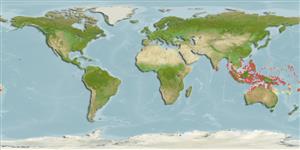Environment: milieu / climate zone / depth range / distribution range
Ecologia
marinhas associadas(os) a recifes; não migratória; intervalo de profundidade 1 - 12 m (Ref. 90102), usually 2 - 3 m (Ref. 9790). Tropical; 19°N - 23°S
Western Pacific: Philippines, Borneo, Moluccas, Papua New Guinea, New Caledonia, Palau, and Yap Island to Ishigaki Island. Range extended to Mentawai Islands (Indonesia).
Tamanho / Peso / Idade
Maturity: Lm ? range ? - ? cm
Max length : 50.0 cm TL macho/indeterminado; (Ref. 9710); common length : 35.0 cm TL macho/indeterminado; (Ref. 9790)
Espinhos dorsais (total) : 9 - 10; Raios dorsais (total) : 11; Espinhos anais: 0; Raios anais : 11. Small juveniles all black, gradually changing to the blotched pattern of the adult (Ref. 48635). Rear edge of maxilla ends well in front of eye. Prominent pit present behind upper eye. Preopercular spines short, usually 2, subequal. Infraorbital ridge usually smooth over eye. Suborbital ridge largely smooth, bearing 2 spines below eye. Oblique scale rows slanting backward above lateral line more or less equals number of lateral-line scales. Dermal papillae (10-12 in adults) on upper eye, some simple, some branched, longest not reaching supraorbital ridge. Interopercular flap usually broader than long, with several subdivisions.
Lives on sand or rubble substrates of sheltered or semi-exposed reefs to a depth of at least 8 m (Ref. 9710). Well camouflaged on reefs (Ref. 48635). Also found in coral reefs and mangrove area in about 1-12 m (Ref 90102).
Ciclo de vida ou comportamento de acasalamento
Maturidade | Reprodução | Desova | Ovos | Fecundidade | Larvas
Myers, R.F., 1991. Micronesian reef fishes. Second Ed. Coral Graphics, Barrigada, Guam. 298 p. (Ref. 1602)
Status na Lista Vermelha da UICN (Ref. 130435: Version 2024-2)
Ameaça para os humanos
Harmless
Uso pelos humanos
Pescarias: pesca de subsistência
Ferramentas
Relatórios especiais
Baixar XML
Fontes da internet
Estimates based on models
Preferred temperature (Ref.
123201): 27.8 - 29.3, mean 28.8 °C (based on 1532 cells).
Índice de diversidade filogenética (Ref.
82804): PD
50 = 0.5625 [Uniqueness, from 0.5 = low to 2.0 = high].
Bayesian length-weight: a=0.00525 (0.00315 - 0.00874), b=3.12 (2.97 - 3.27), in cm total length, based on LWR estimates for this species & (Sub)family-body (Ref.
93245).
Nível Trófico (Ref.
69278): 4.5 ±0.0 se; based on diet studies.
Resiliência (Ref.
120179): médio(a), tempo mínimo de duplicação da população 1,4 - 4,4 anos (Preliminary K or Fecundity.).
Fishing Vulnerability (Ref.
59153): Moderate vulnerability (40 of 100).
Nutrients (Ref.
124155): Calcium = 46.7 [23.0, 116.0] mg/100g; Iron = 0.631 [0.277, 1.412] mg/100g; Protein = 18.1 [15.9, 20.2] %; Omega3 = 0.116 [0.049, 0.325] g/100g; Selenium = 28 [14, 78] μg/100g; VitaminA = 130 [46, 351] μg/100g; Zinc = 0.916 [0.587, 1.443] mg/100g (wet weight);
